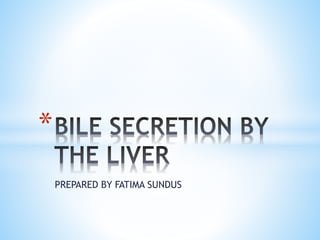
GALLBLADDER AND BILE (2).pptx
- 1. PREPARED BY FATIMA SUNDUS *
- 3. Bile is the greenish-yellow fluid (consisting of waste products, cholesterol, and bile salts)
- 6. One of the many functions of the liver is to secrete bile, normally between 600 and 1000 ml/day. First, bile plays an important role in fat digestion and absorption, not because of any enzymes in the bile that cause fat digestion, but because bile acids
- 7. The bile do two things: (1) They help to emulsify the large fat particles of the food into many minute particles, the surface of which can then be attacked by lipase enzymes secreted in pancreatic juice
- 8. (2) they aid in absorption of the digested fat end products through the intestinal mucosal membrane. bile serves as a means for excretion of several important waste products from the blood. These include especially bilirubin, an end product of hemoglobin destruction, and excesses of cholesterol.
- 9. Bilirubin is a yellowish pigment that is made during the normal breakdown of red blood cells
- 10. Bile is secreted in two stages by the liver: 1) The initial portion is secreted by the principal functional cells of the liver, the hepatocytes this initial secretion contains large amounts of bile acids, cholesterol, and other organic constituents. It is secreted into minute bile canaliculi that originate between the hepatic cells
- 14. (2) the bile flows in the canaliculi toward the interlobular septa, where the canaliculi empty into terminal bile ducts and then into progressively larger ducts, finally reaching the hepatic duct and common bile duct. Common bile duct Hepatic duct Terminal bile ducts Bile canaliculi Hepatocytes BILE FLOW
- 15. 2) a second portion of liver secretion is added to the initial bile. This additional secretion is a watery solution of sodium and bicarbonate ions. The second secretion is stimulated especially by secretin, which causes release of additional quantities of bicarbonate ions to supplement the bicarbonate ions in pancreatic secretion (for neutralizing acid that empties into the duodenum from the stomach).
- 16. Storing and Concentrating Bile in the Gallbladder. Bile is secreted continually by the liver cells, but most of it is normally stored in the gallbladder until needed in the duodenum. The maximum volume that the gallbladder can hold is only 30 to 60 milliliters. Nevertheless, as much as 12 hours of bile secretion (usually about 450 milliliters) can be stored in the gallbladder because water, sodium, chloride, and most other small electrolytes are continually absorbed through the gallbladder mucosa, concentrating the remaining bile constituents that contain the bile salts, cholesterol, lecithin, and bilirubin
- 18. .
- 19. Composition of Bile the composition of bile when it is first secreted by the liver and then after it has been cocentrated and stored in the gallbladder the most abundant substances secreted in the bile are bile salts
- 21. Cholecystokinin. 1. The mechanism of gallbladder emptying 2. relaxation of the sphincter of Oddi The gallbladder is also stimulated less strongly by acetylcholine- secreting nerve fibers from both the vagi and the intestinal enteric nervous system.
- 23. When fat is not in the food, the gallbladder empties poorly, but when significant quantities of fat are present, the gallbladder normally empties completely in about 1 hour
- 24. The liver cells synthesize about 6 grams of bile salts daily. The precursor of the bile salts is cholesterol, which is either present in the diet or synthesized in the liver cells during the course of fat metabolism. The cholesterol is first converted to cholic acid or chenodeoxycholic acid in about equal quantities. These acids in turn combine principally with glycine and to a lesser extent with taurine to form glyco- and tauro-conjugated bile acids. The salts of these acids, mainly sodium salts, are then secreted in the bile.
- 27. The bile salts have two important actions in the intestinal tract: First, they have a detergent action on the fat particles in the food. This decreases the surface tension of the particles and allows agitation in the intestinal tract to break the fat globules into minute sizes. This is called the emulsifying or detergent function of bile salts.
- 28. bile salts help in the absorption of (1) fatty acids (2) monoglycerides (3) cholesterol (4) other lipids from the intestinal tract They do this by forming small physical complexes with these lipids; the complexes are called micelles, and they are semisoluble in the chyme
- 31. Enterohepatic Circulation of Bile Salts. About 94 percent of the bile salts are reabsorbed into the blood from the small intestine, about one half of this by diffusion through the mucosa in the early portions of the small intestine and the remainder by an active transport process through the intestinal mucosa in the distal ileum. They then enter the portal blood and pass back to the liver. In this way, about 94 percent of all the bile salts are recirculated into the bile, so on the average these salts make the entire circuit some 17 times before being carried out in the feces. This recirculation of the bile salts is called the enterohepatic circulation of bile salts.
- 34. Role of Secretin in Controlling Bile Secretion. bile acids to cause bile secretion, the hormone secretin that also stimulates pancreatic secretion increases bile secretion, This increase in secretion is almost entirely secretion of a sodium bicarbonate–rich watery solution. The bicarbonate in turn passes into the small intestine and joins the bicarbonate from the pancreas in neutralizing the hydrochloric acid from the stomach.
- 36. Gallstones form when bile stored in the gallbladder hardens into stone-like material. Too much cholesterol, bile salts, or bilirubin (bile pigment) can cause gallstones